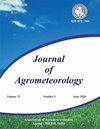Ancient science of weather forecasting in India with special reference to rainfall prediction
Q3 Agricultural and Biological Sciences
引用次数: 0
Abstract
The monsoon on the Indian subcontinent remains a seasonal occurrence that all inhabitants of the subcontinent desire. Modern scientific knowledge of methods of rain forecasting has originated recently. However, traditional indigenous wisdom is peculiar to our country. In the past, India had a magnificent scientific and technical legacy. Even today, it is common that village astrologers (pandits) are right in a surprisingly high percentage of their rain predictions. Scientists and local traditional farmers have a long history of astronomical research and treatises that predict rainfall. They use different methods to forecast rainfall conditions based on numerous panchangs, almanac bio-indicators (Bhoum method), non-bio-indicators (Antariksh method), and predict the likely behavior of climate in the planting season. Rainfall forecasting also aids in the planning of operations by agriculturists, builders, water supply engineers, and others. All mortals from the subcontinent have looked at it from their own perspective, and it continues to be the subject of intense multi-dimensional engagement. The monsoon has provided a means of life for numerous civilizations while also shaping the drainages and palaeo-geography of the subcontinent. The objective of this article is to document some indigenous knowledge for forecasting climate and environmental dynamics towards community resilience.印度古代天气预报科学,特别是降雨量预测
印度次大陆的季风仍然是次大陆所有居民所向往的季节性天气。有关降雨预报方法的现代科学知识起源于最近。然而,传统的本土智慧是我国特有的。过去,印度拥有丰富的科学技术遗产。即使在今天,乡村占星家(pandits)对降雨预测的正确率也高得惊人。科学家和当地传统农民的天文研究和预测降雨的论文由来已久。他们使用不同的方法来预测降雨情况,这些方法基于大量的潘昌图、历书生物指标(Bhoum 法)、非生物指标(Antariksh 法),并预测种植季节可能出现的气候行为。降雨预报还有助于农业专家、建筑师、供水工程师等制定作业计划。所有来自次大陆的凡人都从各自的角度看待季风,而季风仍然是人们从多维度密切关注的主题。季风为无数文明提供了生存手段,同时也塑造了次大陆的排水系统和古地理。本文旨在记录一些本土知识,用于预测气候和环境动态,以提高社区的复原力。
本文章由计算机程序翻译,如有差异,请以英文原文为准。
求助全文
约1分钟内获得全文
求助全文
来源期刊

Journal of Agrometeorology
农林科学-农艺学
CiteScore
1.40
自引率
0.00%
发文量
95
审稿时长
>12 weeks
期刊介绍:
The Journal of Agrometeorology (ISSN 0972-1665) , is a quarterly publication of Association of Agrometeorologists appearing in March, June, September and December. Since its beginning in 1999 till 2016, it was a half yearly publication appearing in June and December. In addition to regular issues, Association also brings out the special issues of the journal covering selected papers presented in seminar symposia organized by the Association.
 求助内容:
求助内容: 应助结果提醒方式:
应助结果提醒方式:


